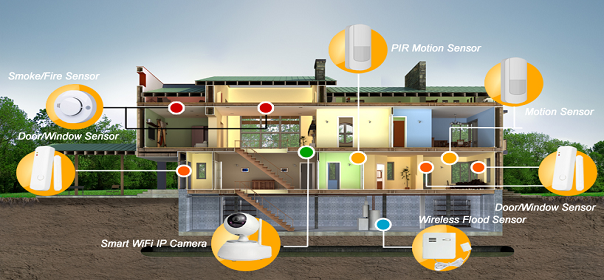Security sensors provide the first line of defense for any home security system. These are the devices that monitor activity in and around your house, and signal the security system if something suspicious happens. This could be anything from an open window or door to leaking water on the laundry room floor. In order to detect the myriad of security breaches and environmental problems that can happen in your household, you’ll need to install a variety of different types of security sensors.
Keep your home and everything inside of it safe and sound:
Install smoke detectors in every room: Every room of your home should have at least one working smoke detector. A smoke detector can help save lives and will alert you and your family to a fire 24 hours a day. Awake or asleep, a smoke alarm is always working, scanning the air to detect smoke or fire. The National Fire Protection Association reports that nearly two-thirds of home fire deaths were in homes where there weren’t any working smoke alarms.
Don’t forget about carbon monoxide detectors: Carbon monoxide is known as the “silent killer” because the gas is colorless, odorless, and tasteless. It cannot be detected by humans without the help of a carbon monoxide detector. According to the Consumer Product Safety Commission, approximately 170 people die every year in the United States from carbon monoxide poisoning.
Door and window contacts: These come in both wired and wireless versions and are responsible for monitoring a home’s perimeter, making them an effective tool for detecting break-ins. Door and window contacts come in two pieces: One part attaches to the door or window and the other to the door or window frame. Both parts are magnetized, so when they pull apart (such as when a window or door opens), they trigger, sending an alarm signal (either over wire or wirelessly) to the hub of the security system. The hub can be programmed to react several different ways, depending on the time of day.
Motion sensors: As the name suggests, this type of sensor watches for and reacts to motion within a predefined area. Motion sensors are typically used to protect certain spaces within your home, like the bedrooms, hallways, kitchen, and other areas where a burglar or vandal might roam. They are also effective tools for keeping tabs on the whereabouts of your kids, babysitters, housecleaners, and other individuals who frequent your home. They react to the “heat” of a person who walks into their field of vision by signaling the security system, which can respond by sounding a chime, an alarm, sending you a text, or even switching on the nearest surveillance camera so you can see via your smartphone who may have tripped the sensor.
Outdoor motion sensors: The inside of your home isn’t the only place that deserves a layer of protection. Think also about your backyard, the garage, and outbuildings. Outdoor motion sensors are designed to withstand the elements and ignore movement by your pets. Both indoor and outdoor motion detectors are covert enough to go virtually unnoticed.
Glassbreak detectors: If a burglar can’t open a window, he will probably just break it instead. Double your perimeter protection by adding glass breaks detectors throughout your home. They listen for the audible “signature” of breaking glass. Unlike window contacts, a single glass break detector can monitor several windows within an area.
Smart Window Locks: Andersen and Honeywell Pair Up to Create a More Secure Window Standard home security sensors can tell you if a window is closed but they can’t detect if the sash is locked—always a good defense against home invasion. As an additional benefit, a locked window is more energy efficient than one that’s unlocked. While it’s protecting your house, the VeriLock sensors can maximize your home’s energy efficiency.
Water detectors: Whether they respond to water from a leaky pipe or a cracked fish tank, water detectors can save your house from serious and costly flood damage. Most are wireless, and can be placed underneath sinks, beside a washing machine, or anywhere else where water could potentially accumulate. The main responsibility of this type of sensor is notification. When water is detected, it can initiate the transmission of an email or text message to your smartphone. You’ll be able to respond quickly to the problem and, if you’re out of town, use the smarts of your security system to turn off the water valve remotely (this requires extra hardware).
Power outage detectors and other environmental sensors:Blackouts can ruin a freezer’s worth of food, humidity can be bad for an art collection, extreme temperature swings can jeopardize the contents of a wine cellar. A variety of sensors are available that monitor the environment of your home.
Asset detectors: If the door/window and motion sensors didn’t catch the crook, an asset sensor will. Placed inside an expensive vase, attached to the back of a big-screen TV and any other items of personal or financial value, this type of detector’s built-in accelerometer senses the movement of an object. Should someone lift a framed piece of art off the wall, the accelerometer notices, sending you a notification or sounding an alarm..

